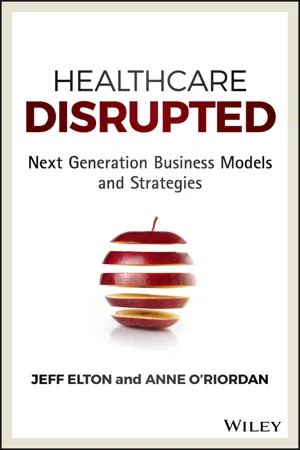
Healthcare Disrupted
Next Generation Business Models and Strategies
- English
- ePUB (mobile friendly)
- Available on iOS & Android
About this book
"During a time of tremendous change and uncertainty, Healthcare Disrupted gives executives a framework and language to determine how they will evolve their products, services, and strategies to flourish in a increasingly value-based healthcare system. Using a powerful mix of real world examples and unanswered questions, Elton and O'Riordan lead you to see that 'no action' is not an option—and push you to answer the most important question: 'What is your role in this digitally driven change and how can your firm can gain competitive advantage and lead?'"— David Epstein, Division Head, Novartis Pharmaceuticals
"Healthcare Disrupted is an inspirational call-to-action for everyone associated with healthcare, especially the innovators who will develop the next generation of therapeutics, diagnostics, and devices."— Bob Horvitz, Ph.D., David H. Koch Professor of Biology, MIT; Nobel Prize in Physiology or Medicine
"In a time of dizzying change across all fronts: from biology, to delivery, to the use of big data, Health Disrupted captures the impact of these forces and thoughtfully develops new approaches to value creation in the healthcare industry. A must-read for those who strive to capitalize on change and reinvent the industry."— Deborah Dunsire, M.D., president and CEO, FORUM Pharmaceuticals
Healthcare at a Crossroad: Seismic Shifts, New Business Models for Success
Healthcare Disrupted is an in-depth look at the disruptive forces driving change in the the healthcare industry and provides guide for defining new operating and business models in response to these profound changes.
Based on original research conducted by Accenture and years of experience working with the most successful companies in the industry, healthcare experts Jeff Elton and Anne O'Riordan provide an informed, insightful view of the state of the industry, what's to come, and new emerging business models for life sciences companies play a different role from the past in to driving superior outcomes for patients and playing a bigger role in creating greater value for healthcare overall. Their book explains how critical global healthcare trends are challenging legacy strategies and business models, and examines why historical leaders in the industy must evolve, to stay relevant and compete with new entrants.
Healthcare Disrupted captures this pivotal point in time to give executives and senior managers across pharmaceutical, biopharmaceutical, medical device, medical diagnostics, digital technology, and health services companies an opportunity to step back and consider the changing landscape. This book gives companies options for how to adapt and stay relevant and outlines four new business models that can drive sustainable growth and performance. It demonstrates how real-world data (from Electronic Medical Records, health wearables, Internet of Things, digital media, social media, and other sources) is combining with scalable technologies and advanced analytics to fundamentally change how and where healthcare is delivered, bridging to the health of populations, and broadening the resposibility for both. It reveals how this shift in healthcare delivery will significantly improve patient outcomes and the value health systems realize.
Frequently asked questions
- Essential is ideal for learners and professionals who enjoy exploring a wide range of subjects. Access the Essential Library with 800,000+ trusted titles and best-sellers across business, personal growth, and the humanities. Includes unlimited reading time and Standard Read Aloud voice.
- Complete: Perfect for advanced learners and researchers needing full, unrestricted access. Unlock 1.4M+ books across hundreds of subjects, including academic and specialized titles. The Complete Plan also includes advanced features like Premium Read Aloud and Research Assistant.
Please note we cannot support devices running on iOS 13 and Android 7 or earlier. Learn more about using the app.
Information
Part I
The Tsunami of Change
Chapter 1
Why and How the Healthcare Industry is Changing So Rapidly
The collective throw-weight of socio-economic and policy changes, technological advances, and structural shifts has primed the healthcare industry for upheaval and disruption—and presented an incredible opportunity to advance the standard of care worldwide.


Opportunities
The Signs of Change
A Closer Look at Healthcare Reform
Table of contents
- Cover
- Title Page
- Copyright
- Preface
- Acknowledgments
- Introduction
- Part I: The Tsunami of Change
- Part II: From Strategy to Value with New Business Models
- Part III: Building New Organizations
- Part IV: Looking Back—Looking Forward
- Glossary
- About the Authors
- Index
- End User License Agreement